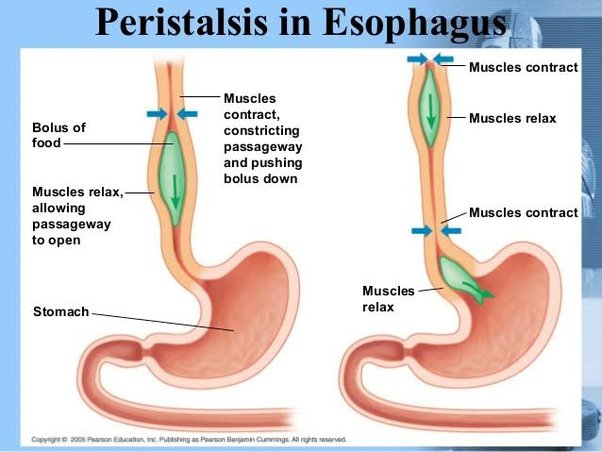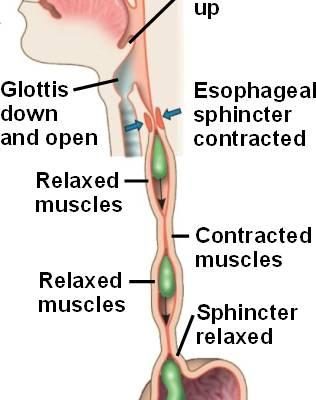Table of Contents
What is Peristaltic Movement?
Peristaltic movement, also called Peristalsis, is a wave-like contraction and relaxation of muscles in the digestive tract that moves food through the gastrointestinal tract (GI). This coordinated muscular activity begins in the oesophagus and continues through the stomach, small intestine and large intestine.
The muscles in the digestive tract are divided into two layers –
- Circular
- Longitudinal
The circular muscles encircle the digestive tract, while the longitudinal muscles run parallel to its length. When the circular muscles contract, they exert pressure on the food and push it forward. At the same time, the longitudinal muscles contract, shortening the length of the digestive tract and thus assisting the forward movement of the food.
The enteric nervous system, a network of nerves located in the walls of the digestive tract, coordinates these muscle contractions. The enteric nervous system is often referred to as the “second brain” and controls the muscle movements necessary for peristalsis independently of the central nervous system.
Peristalsis plays a crucial role in the digestive process by facilitating the movement of food along the GI tract, ensuring efficient nutrient absorption and waste elimination.
Also Check – Peristalsis- The Rhythmic Journey Through Your Body
Location of Peristalsis
Peristalsis occurs in several key areas of the digestive system, namely the oesophagus, stomach and intestines.
Oesophagus
The oesophagus is a muscular tube that connects the mouth to the stomach. When we swallow food, peristalsis helps push the food down the oesophagus and into the stomach. The muscle contractions in the oesophagus create a wave-like motion that propels the food forward.
Stomach
In the stomach, peristalsis plays a crucial role in mixing and churning food with gastric juice. The stomach contracts and relaxes in a coordinated way, creating peristaltic waves that aid the digestive process. These waves help break down the food into smaller particles and mix them with digestive enzymes.
Intestines
Peristalsis is especially important in the intestines, which consist of the small intestine and the large intestine (colon).
Small Intestine
In the small intestine, peristaltic contractions propel partially digested food forward. These contractions help to mix the food with digestive enzymes and promote the absorption of nutrients into the bloodstream.
Large Intestine ( Colon )
In the colon, peristalsis helps move waste, including undigested food particles, water and bacteria, through the colon. This process allows the reabsorption of water and electrolytes and results in the formation of faeces.
Also Check- Process of Digestion in Human Beings
Mechanism of Peristaltic Movement

Mechanism of Peristaltic Movement in Digestion
- Muscular contractions- The muscles in the digestive tract work in a coordinated wave-like motion called peristalsis. Two layers of muscles are involved: circular muscles and longitudinal muscles. The circular muscles surround the digestive tract, while the longitudinal muscles run parallel to its length. When the circular muscles contract, they squeeze the food and push it forward. At the same time, the longitudinal muscles contract to shorten the length of the digestive tract to help the food move forward.
- Contraction pushes the food forward – The contraction of the muscles creates a pressure that pushes the food forward. The strongest force occurs at the point where the muscles contract. It gradually decreases as the food moves away from the point of contraction.
- The relaxation enables the forward movement – Muscle relaxation occurs in a wave-like pattern, allowing food to move smoothly and continuously through the digestive tract. When the muscles relax, the food can move further through the Alimentary Canal .
- Sequential Movement – Peristaltic waves facilitate the movement of food from the mouth into the stomach, then into the small intestine and finally into the large intestine. The waves begin in the oesophagus, continue through the stomach and propel the partially digested food (known as chyme) through the small intestine where nutrient absorption occurs. The remaining waste products then move into the large intestine.
- Stomach Churning and Mixing – In the stomach, peristaltic contractions churn the food and mix it with digestive juices. This process helps to break down the food into smaller molecules that can be further digested and absorbed.
- Small Intestine Digestion and Absorption – In the small intestine, food is broken down into even smaller molecules that can be easily absorbed by the body. The inner lining of the small intestine is covered with finger-like projections called villi, which increase the surface area available for absorption and allow nutrients to be absorbed efficiently.
- Water Absorption in the Large Intestine – When food reaches the large intestine, water absorption takes place. The large intestine removes water from the remaining food, leading to the formation of more solid waste products. These waste products along with indigestible substances,are stored in the large intestine until elimination from the body.
Also Check – Nutrition in Human Beings – class 10
Also Check – 9 Important Function of Stomach in Digestive System
Frequently asked Important questions on Peristaltic Movement
What is a peristaltic movement?
Answer – Peristaltic movement, also called peristalsis, is a wave-like contraction and relaxation of the muscles in the digestive tract that helps move food through the gastrointestinal tract.
Which muscles are involved in peristalsis?
Answer – The muscles involved in peristalsis are the circular muscles and the longitudinal muscles of the digestive tract.
How do the circular muscles contribute to peristalsis?
Answer – The circular muscles contract and exert pressure on the food, pushing it forward through the digestive tract.
What role do the longitudinal muscles play in peristalsis?
Answer – The longitudinal muscles contract, shortening the length of the digestive tract and assisting the forward movement of the food.
Also Check – Gut peristalsis is governed by a multitude of cooperating mechanisms
What is the location of peristalsis in the digestive system?
Answer – Peristalsis occurs in the oesophagus, stomach and intestines.
How does peristalsis work in the oesophagus?
Answer – Peristalsis helps push food down the oesophagus and into the stomach by creating wave-like movements that propel the food forward.
What is the role of peristalsis in the stomach?
Answer – Peristalsis in the stomach helps to mix and churn the food with the gastric juices. It helps to break down the food into smaller particles and mix them with digestive enzymes.
How does peristalsis work in the small intestine?
Answer – Peristaltic contractions in the small intestine propel the partially digested food forward, mixing it with digestive enzymes and promoting the absorption of nutrients into the bloodstream.
What is the function of peristalsis in the large intestine?
Answer – Peristalsis in the large intestine helps move waste, including undigested food particles, water and bacteria, through the colon. It allows the reabsorption of water and electrolytes, resulting in the formation of faeces.
How do the muscles of the digestive tract work in peristalsis?
Answer – The circular muscles contract to squeeze and push the food forward, while the longitudinal muscles contract to shorten the length of the digestive tract and move food forward.
How does peristalsis work in the digestive system?
Answer – Peristaltic waves facilitate the movement of food from the mouth into the stomach, then into the small intestine and finally into the colon.
How do peristalsis contribute to stomach churning and mixing?
Answer – The Peristaltic contractions in the stomach cause food to be churned and mixed with digestive juices, promoting the breakdown of food into smaller molecules for digestion and absorption.
What happens in the small intestine during digestion and absorption?
Answer – In the small intestine, food is further broken down into smaller molecules that can be easily absorbed by the body. The inner lining of the small intestine, which is covered with finger-like projections called villi, increases the surface area for efficient nutrient absorption.
What happens in the large intestine during peristalsis?
Answer – Water absorption takes place in the large intestine. The large intestine removes the water from the remaining food, creating more solid waste products that are stored until elimination from the body.


One Comment on “What is Peristaltic Movement – Class 10”